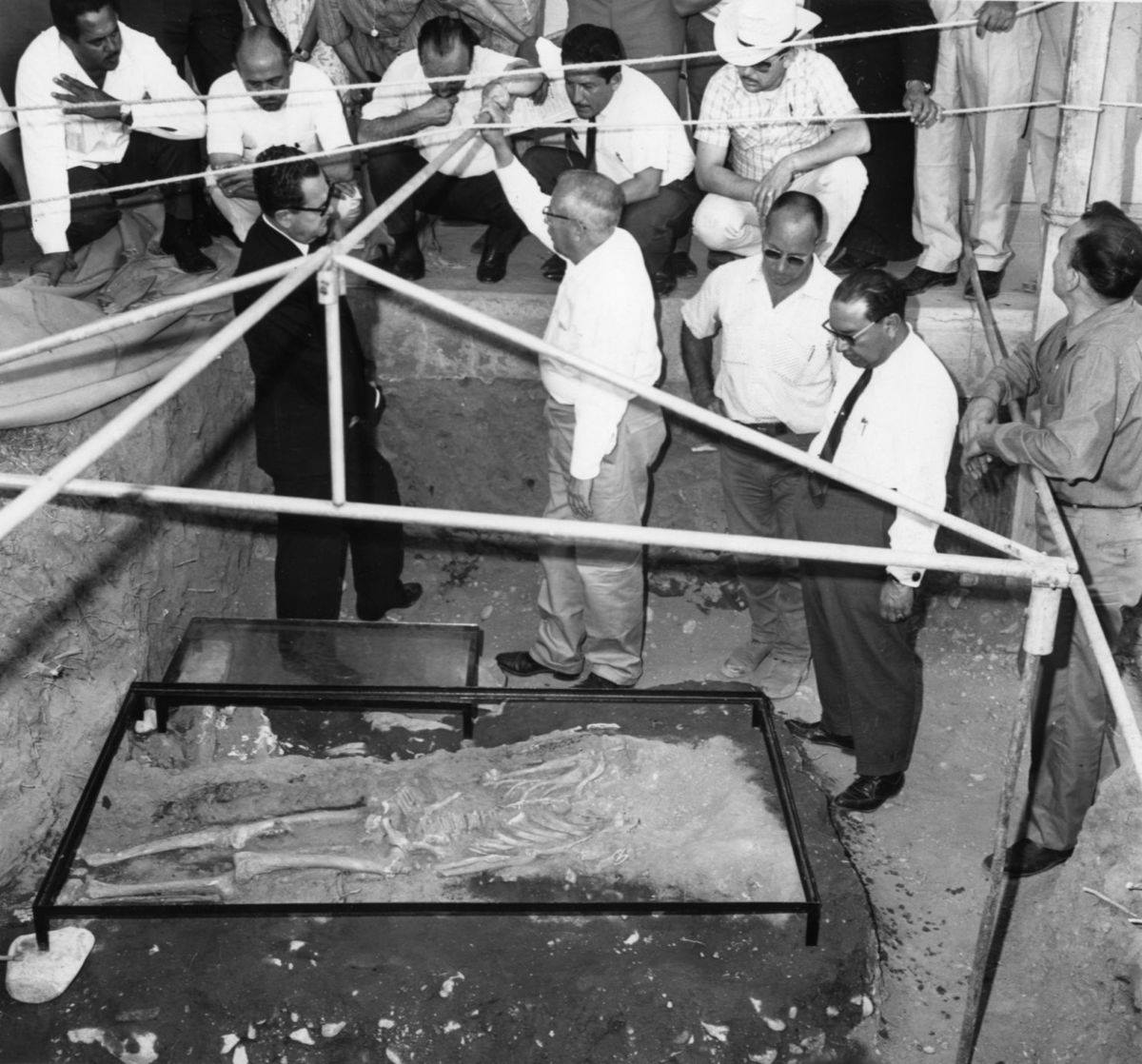Jorge Olvera Account
Kino Grave Discovery
Page 3
Discovery Account from excerpts of the 1998 book by Jorge Olvera H.
"Finding Father Kino: The Discovery of the Remains of Father Eusebio Francisco Kino, S.J. 1965 -1966"
Building Identification
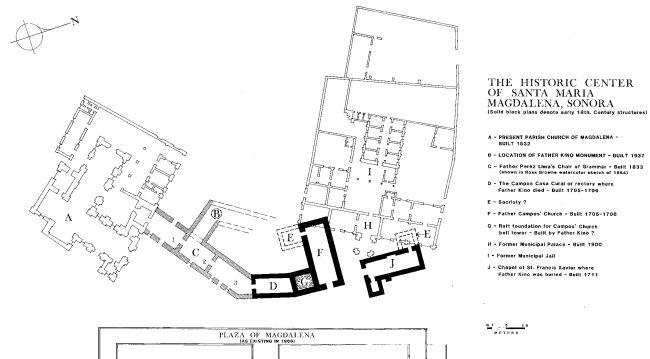
Notes on Buildings Identified Above
The Kino Chapel is also called "La Capilla" and "Chapel of San Francisco Xavier." Kino was buried in the Chapel after he dedicated it in 1711. It was destroyed completely in the earthquake of 1887 (J). The Campos Church was started in 1705 and its destruction date is unknown but it was before the 1879 Pinart drawing (F). City Hall is also called "Palacio Muncipal" It was built 1910 and demolished to build the Kino National Mausoleum and the Kino Monument Plaza in 1970 (H). Present Magdalena Church is also called "Santa Maria Magdalena Church." It was built 1832 and is the present parish church and is located in the Kino Monument Plaza (A). The building footprints shown in bold solid lines existed at the time of Kino's death.
Kino Burial Records
August 7, 1965
Saturday Magdalena, Sonora
The Record of Father Kino's Burial: The original burial register containing the notice of death and burial of Father Kino no longer exists in the parish archives of Magdalena. Thanks to Alphonse Pinart's theft, it has come to rest instead - along with other Sonoran church registers - in the Bancroft Library on the campus of the University of California in Berkeley. Many years ago, and at his own expense, American anthropologist and historian Dr. Henry F. Dobyns had photostatic copies made of the original records in the Bancroft Library. He presented these to the Reverend Santos Saenz, pastor of the Magdalena parish.
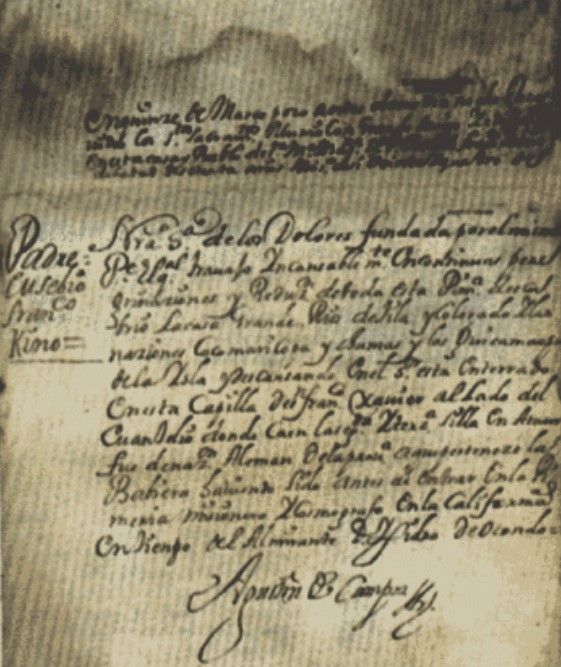
Kino Burial Record - Copy of Original
It is from one of these excellent photographic copies that I now transcribe the exact wording of the death notice of Father Kino from the Magdalena burial register. |41| I start with the original Spanish script before continuing with the precise English translation:
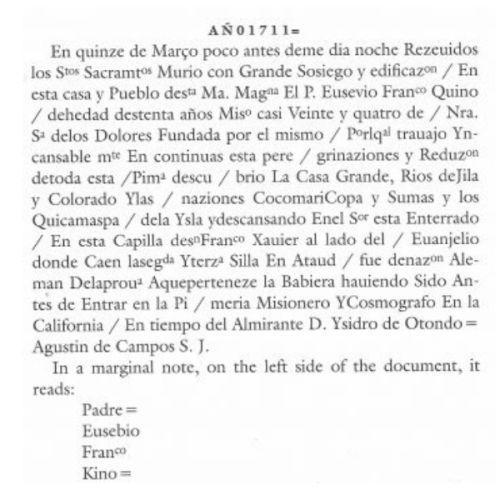
The correct English version is as follows:
The Year 1711 On the fifteenth of March just before midnight, having received the Holy Sacraments, Father Eusebio Francisco Kino died with great peace and edification in this house and Pueblo of Santa Maria Magdalena at the age of seventy years [sic], having been for nearly twenty-four years missionary of Nuestra Señora de los Dolores, which he himself founded. He toiled without rest in continuous peregrinations and in the reduction and settlement of all this Pimeria. He discovered the Casa Grande, the Gila and Colorado rivers; the Cocomaricopa and Suma nations and the Quicamaspa of the Island, and now resting in the Lord, he is buried in a coffin in this chapel of San Francisco Xavier on the Gospel side where fall the second and third ashlars. He was a German by nationality and of the province to which Bavaria belongs, and before he entered the |42| Pimería he had been missionary and cosmographer in California in the time of Admiral Don Ysidro de Otondo = Agustin de Campos, S.J, [rubric]
Superimposition of Images Locates Kino Chapel
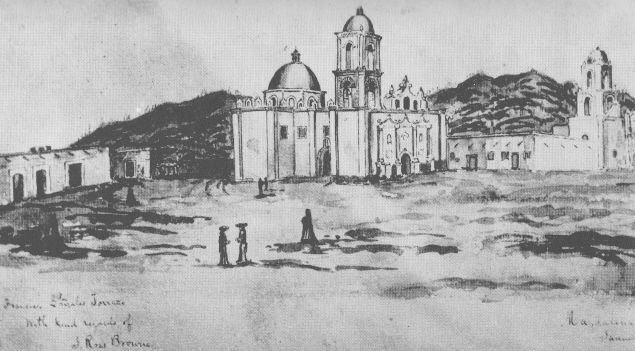
J. Ross Browne Drawing - 1864 - Figure 51
Present Magdalena Church (left) and Campos Church (right)
May 12, 1966
Thursday Magdalena, Sonora
On the day I received the Pinart sketch from George Eckhart, I started to study it very carefully. For there in the drawing, looking me in the eye, as it were, was the present church of Magdalena. And to the right in the sketch were the ruins of an old religious edifice with a big mound of earth in front of a rather small tower. By studying the perspective, it was possible to see that the proportions of this tower compared with those of the present church were not those of a large, massive tower. The J. Ross Browne watercolor, on the other hand, shows the Campos church with a tower of more or less large proportions. Then I noticed several other differences between the Campos church as shown in Browne's watercolor and the church and bell tower in the Pinart sketch. The Pinart drawing shows part of a facade which had not yet collapsed. Its small arched entrance is still to be seen. However, while the facade seems to be abutted to the tower, as it really was, we are not seeing the front of it, but the back, as indicated by the shading in the drawing. Pinart was looking at the ruins of this religious structure from where the apse had been; that is, from the back. This tells us that the facade of this building was almost facing Father Comella's "casa cural," and not the Magdalena plaza. The Campos |204| church in Browne's watercolor, on the other hand, is clearly facing the plaza.
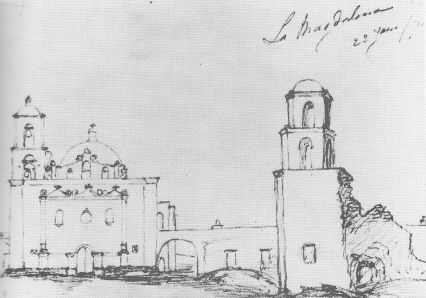
Alphonse Pinart Drawing - 1879 Figure 50
Present Magdalena Church (left) and Kino Chapel (right)
Another important difference in these two sketches is that while the bell tower of the Campos church was provided with a very large defensive staircase, one similar to that seen today on the west bell tower of Mission San Xavier del Bac, the bell tower in Pinart's drawing has no such staircase. This means that the belfry in the latter tower was most probably reached by a spiral staircase fashioned out of mesquite.
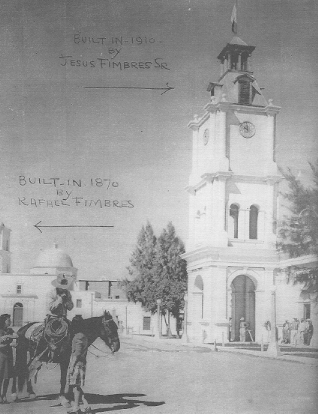
Photograph of Magdalena by Unknown Photographer - After 1937 Figure 60
Present Magdalena Church (left) and City Hall (right)
As if to confirm my hypothesis, I had been given an excellent old photograph that showed part of the facade of the present church as well as the clock tower of the Palacio Municipal (see Fig. 62). Amazingly, the photograph had been taken almost from the exact place, angle, and distance where Pinart had situated himself when he made his drawing.
The details of the facade of the 1832 church are so well drawn that it would be possible in the future to restore it precisely to its original form.
The old photograph showed the place, later walled in with another story added to it (see Fig. 63), where the arched entrance to the casa cural used to be. It also showed the two doors to the right of where the large and imposing arch had been.
There was only one thing to do, and that was to superimpose the Pinart drawing on the photograph. In this new drawing, a mounted cowboy lighting his cigarette and two young girls are in the foreground (Fig. 64). The photograph is undated, but it was probably taken after 1937 when, according to an informant interviewed by Professor Jimenez Moreno, the local Monument to Father Kino was erected. In spite of its hazy appearance, this monument can be seen in the photograph behind the horse's head and in the distance in front of the casa cural.
Also, the facade of the present church is here the same as in another photograph taken by Western Ways of Tucson, Arizona, and dated 1938 (see Fig. 56). In this photo, the Kino monument is seen in the foreground.
The year 1937, given by Professor Jimenez Moreno's local informant as the date when the monument was built, is probably correct. Professor Eduardo W. Villa (1937: 130-131), explaining how he and Serapio Davila excavated in Magdalena in 1936 to try to find Father Kino's remains, wrote that when they thought they had finally found the foundations of the chapel in which Father Kino had been buried (which were actually the foundations of Father Pérez Llera's school), they conceived the idea of erecting a monument to Father Kino right there. Later in 1936, Professor Villa began to work on this project. |205 |
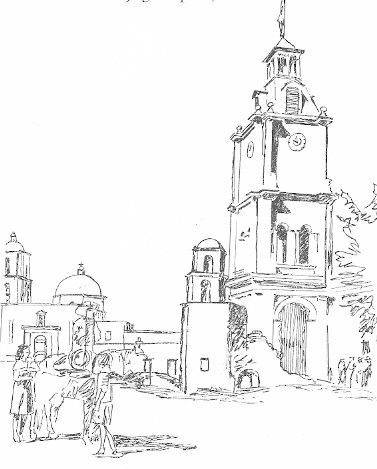
Jorge Olvera's Composite Sketch Tracing - 1966 Figure 64
1938 Photo of Magdalena (Figure 63) overlayed by 1879 Pinart Drawing (Figure 50) Reveals Location of Kino Chapel Foundations Within Inches of City Hall Clock Tower Present Church (left) and Kino Chapel (center) and City Hall (right)
Using tracing paper, I tried several superimpositions using excellent registration points that nearly matched in Pinart's drawing and in the photograph. These points were in the arched entrance to Father Comellas's casa cural. The photograph indicated the same entrance, but by 1938 it had been walled in and converted into a small building raised a little higher over the arch. The outline of this arch could still be seen in 1966 on the face of the building, which later became the office for the parish notary. The curvature of the arch could clearly be seen in the wall where the plaster had flaked off because of differential settlement of the lower walled-in portion. I took a good photograph of this architectural witness (Fig. 63).
Dr. Wasley had noticed the existence of this walled-in arch in 1965, for he included it in a quick sketch he had made in his field notes of the present church and the casa cural of Father Comellas (Wasley 1966). His drawing, which he labelled "iglesia actual de Santa Maria Magdalena," shows the facade of the present church in a very schematic way. Next to it, he drew the new small building where, according to the Pinart sketch, the arched entrance to the Comellas casa cural used to be, and wrote above it "oficina de la curia." He also drew the arch, cut in half by the window of the upper story, as well as the complete casa cural up to its second entrance and final wall. He wrote above it: "Casa cural de Comellas." Finally, above the last wall of the second entrance, he wrote, "El muro de la casa cural de J. Ross Browne" or, "the wall of the casa cural depicted by J. Ross Browne." Here, however, he was still influenced by Jimenez Moreno's mistaken interpretation of the Browne watercolor. He believed with Jimenez Moreno that this wall was an aligned continuation of the facade of the church when, in reality, it moved away from the church in a perpendicular fashion, as our later excavations of its foundations revealed.
During the final days of the project, and after we had oriented ourselves with Henry C. Pratt's panoramic view of Magdalena that showed us the Campos church used to be located near the Palacio Municipal, Dr. Wasley began to agree with me in everything. … |206|
View and Download "Finding Father Kino's Grave Summary"
Two Page Summary Flyer
Scroll down to bottom of this page.
Jesuit Period Building Foundations

Jesuit Period Building Foundations Figure 77
Boulders in Clay-and-Mud Mortar
May 16, 1966 Monday Magdalena, Sonora Remedios, Sonora Professor Jiménez Moreno saw the advantage of the trip to Remedios. Because we would be examining the foundations and walls built by Father Kino himself, it could tell us definitely whether or not we were finding Jesuit structures in Magdalena. With the discovery of the possible foundations of Father Campos's church, our laborers were now better trained in the identification of Jesuit foundations. We had been trying all along to explain the difference between the natural earthen soil and the clay-and-mud mortar in Jesuit foundations. We also had the opportunity to show them the difference between these and Franciscan foundations, which were not made with boulders, but with quarry stone and lime-and-sand mortar. Franciscan walls, moreover, were made of fired brick, and not with adobe bonded with clay mortar. We had taught them how to excavate Jesuit foundations without destroying them, because the mud-and-clay mortar could be easily mistaken underground for natural hardened earth. We had already trained them to be able to detect Jesuit foundations by the color of the mortar, its texture, its consistency, its composition, etc. ... |271| ...
As soon as he arrived in Magdalena, Romano [INAH Mexico physical anthropologist Arturo Romano Pacheco] very discretely asked me if we had any idea where the long lost chapel and tomb of Father Kino would be.
I told him that Dr. Wasley did, in fact, have a general idea where the chapel foundations could be found, and I believe I told him about our experiences with the Magdalena sketches made by J. Ross Browne and Henry Pratt. I told him that Wasley and I had been happy to have our suspicions confirmed by finding, very near the southeast corner of the Palacio Municipal, a Jesuit foundation made of boulder held together with mud and clay mortar. I seem to recall I also told him that Professor Jimenez Moreno differed with us about the location of the chapel foundations, that the professor continued to believe they were either in the direction of the area around the vacant lot or in the jail yard.
Romano must also have spoken with Dr. Wasley and received confirmation of what I had said. He took my suggestion and started to direct excavation towards the area in front of the clock tower of the Palacio Municipal. ... [208]
Excavations & Records Correspond to Graves of Kino & Others
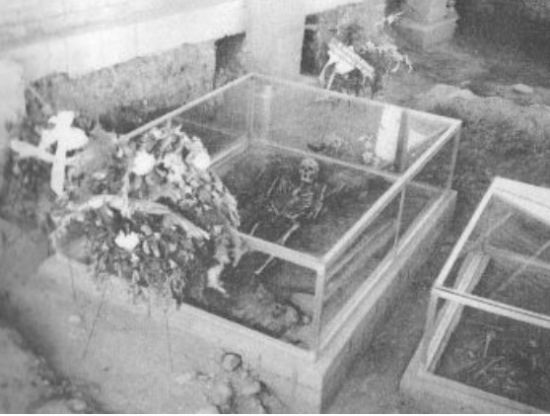
Protective Glass Cases Over Kino's Skeleton
Between Reinterred Remains Padres González & Iturmendi
May 18, 1966
Wednesday Magdalena, Sonora
One of the last foundations still being excavated, oriented northwest to southwest right in front of the entrance to the council chambers (Sala de Cabildos) in the Palacio Municipal, we are almost sure corresponds to the west wall of the chapel of St. Francis Xavier.
Now we can be virtually certain. From among the documents Father McCarty recently brought from San Xavier del Bac in Tucson, he showed us one today strongly supporting our hypothesis -- one that became our first choice two days ago when Professor Jimenez Moreno discovered their northeast corner -- that these foundations are those of the chapel. The document is a transcript copy made by Father McCarty himself of a holograph report by don Fernando Grande, a man who had been sent by the Sonoran vice governor to inspect the missions' economic condition. Titled "Cartas de Sonora" and dated 1828, the original was then extant in the archives of the Colegio de la Santa Cruz de Queretaro.
I am reproducing the original text in Spanish, followed by an English version:
DOCUMENTO NUMERO 19 --1828 [San Ignacio] FABRICA MATERIAL. CAPILLA AYUDA DE PARRA QUIA DEL PUEBLO DE SANTA MARIA MAGDALENA VISITA DE LA MISION DE SAN IGNACIO. -- FABRICA MATERIAL. La Capilla de este pueblo es mediana su materia es de adobe su portada al medio dia presenta una torrecita mediana en que estan colocadas tres campanas y una esquila mediana, no tiene cosa particular que llame la atención, el Altar principal y único esta en el Presbiterio, en el estan colocados una Imagen de Cristo Crucificado con otro de la Virgen de Dolores al pie de talla mayor una menor y la otra de regular escultura y en unos nichos que enforma de retablo hay en la pared del altar estan colocados la Imagen de Santa Magdalena, Patron a del Pueblo, de talla menor buena escultura, un San Francisco Xavier y un Beato José Oriol, ambos de talla y de imperfecta escultura. A medio cuerpo de la Iglesia esta un nicho donde esta colocada en una Urna una Imagen de talla mayor de San Francisco Xavier |228|, objeto de la devoción de toda esta parte alta de Occidente, de hermosa y grave escultura.
DOCUMENT NUMBER 19 -- 1828 [San Ignacio] MATERIAL STRUCTURE. VISITA [mission station] CHAPEL OF THE PUEBLO OF SANTA MARIA MAGDALENA VISITA OF MISSION SAN IGNACIO. MATERIAL STRUCTURE.
The Chapel of this pueblo is of medium size, its material is adobe, its portal faces south and displays a small medium sized bell tower in which there are three bells and a small one. It hasn't any particular attraction. The main and only altar is in the sanctuary. In it are placed an image of Christ Crucified with another one of the Virgin of Dolores at the foot [of the Crucifixion] of a large size carving; another one of minor carving and another of a regular-sized sculpture. And in niches which are in the form of retablos in the wall of the altar are placed the image of Santa Magdalena, patroness of the pueblo, a minor but good sculpture, as well as a San Francisco Xavier and a beatified Jose Oriol, both carved but of imperfect sculpture. In the middle of the church nave there is a niche in which a large sized image of San Francisco Xavier is placed, a beautiful and solemn sculpture that is an object of devotion in all this upper [northern] part of the West.
There are several things which I wish to point out in relation to the chapel of St. Francis Xavier. In the first place, we have a very good drawing of what remained of this chapel in 1879 when Alphonse Pinart sketched its ruins. He was the first and last one to depict it before it completely collapsed after the 1887 earthquake. In what is left of its small bell tower, we can still see that the upper stories of the tower had mudejar chamfered corners and stilted arches of Muslim origin, a tradition continued by Franciscans in the bell towers of San Xavier del Bac and, until they were altered by modern priests, on the original bell towers of the present parish church of Magdalena as can be seen in the Pinart sketch (Fig. 50).
Some of the small sculptures that Fernando Grande mentions in his description of the chapel of San Francisco Xavier in Magdalena, including that of José Oriol, are now in the custody of the Mission of San Ignacio (see Fig. 74). The oldest are real works of art dating from the 17th and 18th centuries. ….
While I was taking photographs of the area in front of the Palacio Municipal from the top of the clock tower, my workers digging in Trench #17b came upon the corner opposite that discovered by Jimenez Moreno. The trench now turned toward the south, making sense of the three isolated fragmentary foundations located in that direction (see Fig. 36, general ground plan of the area in front of Sala de Cabildos) and letting us know they were part of the west wall of a rectangular structure that could very possibly be the chapel. The complete outline of these foundations was now being revealed.
With the corner just found turning towards the south rather than continuing west, the threat to the entrance to the Palacio Municipal was eliminated. This made everyone happy, especially the mayor. I was the happiest, because I was now sure that these foundations were not |230| those of a larger building, such as that of the Campos church, but of a much smaller one. Aided by Conrado Gallegos, and starting from the isolated foundations, I now measured the inner width of the structure. It was approximately 5 meters. We then measured the approximate length of this rectangular structure along its east wall since the west one was incomplete in most parts. The length was 16 meters. As soon as we transferred the measurements onto paper, we saw they accorded with the normal size for a chapel.
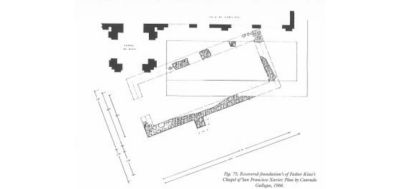
Recovered Foundations of Kino's Chapel Figure 75
Plan by Conrado Gallegos - 1966
As the foundations of the north end of the structure indicated a closed unit, with no gap for a door, we deduced that access to this building would be on its south end. Careful excavations were then carried out in this section. The absence of stone foundations on the south side -- with the exception of a few foundation stones that turned in a westward direction from the southeast corner, assured us that the entrance to the building was on the south, and that it was flush with the starting surface of the east foundation (see Fig. 75, recovered foundations of the chapel).
No foundation stones were found on the west corner of the structure. That area had been greatly disturbed when the clock tower of the Palacio Municipal had been built, and for the same reason, when the facade of the Palacio Municipal and its entrance were built, that other area had also been disturbed. That is why we found the west foundation of the structure in such a fragmentary condition, as can be seen in the illustration (Fig. 75).
Nevertheless, now that the foundations of our hypothetical chapel had been found, we saw that they adequately matched Fernando Grande's description of the chapel of San Francisco Xavier.
In fact, everything matched Fernando Grande's description: the walls that rested on the foundations we had now discovered, in their almost complete form, were of adobe. Not a single vestige of burnt brick had been found. The portal, as Grande wrote, faced south. The building was, as he said, medium sized, and, as we discovered later, it had a bell tower as he had indicated.
The archaeological crew uncovered a burial precisely in the spot where, if this were Kino's chapel, the historical researchers had indicated there should be the remains of a Spaniard, Salvador de Noriega, buried in 1739. If I were right in considering this area to be the south end of Kino's chapel, then the burial, discovered by Dr. Romano and which was currently being excavated by him, was surely that of Salvador de Noriega and the structure behind it was the long lost chapel of San Francisco Xavier. … |231|
May 20, 1966
Friday Magdalena, Sonora
By the time I returned from Tucson in the afternoon, Dr. Romano had managed neatly to lower the level of the excavation of Trench # 17b to the point where the skeletal remains of Burial #2 (which someone now called "Suspect Number 2") could be completely exposed. It was already evident these could be the remains of Father Kino. They were on the Gospel side of the chapel near where the altar would have been. Both Dr. Wasley and I shared this opinion, and Dr. Romano seemed to agree with us.
It was also on this day that the bones of two secondary burials, almost certainly those of Fathers Gonzalez and Iturmendi whom Father Campos had disinterred from Tubutama and reburied here in 1712, were found on either side of the extended primary Burial #2. … |235|
May 21, 1965 Saturday Magdalena, Sonora Suspecting that these remains could be Kino's, I also concentrated on careful exploration of the area of this interment. I looked for the rest of the foundations on the west side of the chapel and for any archaeological data or artifact that might strengthen the certainty this was Kino's chapel.
The entire team was working at a feverish pitch. While Dr. Wasley and I directed other excavations towards the north end of the chapel and Professor Romano took care of the interments, Professor Jimenez Moreno, Father Kieran McCarty, Sanchez de la Vega, and Father Cruz Acuna worked in the parish archives finding more documents supporting the identification of our archaeological finds.
In writing his report on the excavations, Wasley (1966) summarized nicely this correspondence between documentary and archaeological data.
The amazing finds were these:
"1) The historical researchers found documentary evidence that the Jesuit missionary Father Gaspar Stiger, a German [Swiss], had buried a Salvador de Noriega, in life employed by Lorenzo Velasco, just outside the door of the chapel of San Francisco Javier in Santa Magdalena, in August of 1739. The archaeological crew uncovered a burial in just such a spot with reference to one of the Jesuit period structures.
2) The historical researchers revealed that in 1828 the inspector Fernando Grande had stated - for the first time in all of the historical records that we know about - that the chapel faced to the south ("al medio dia") and that the archaeologists were able to determine from the foundations that this same structure did face to the south. It was much later, however, at the very end of the project and actually during the process of |236| winding everything up that Prof. Jorge Olvera finally found the foundations of the tower.
3) In this same document the historians were able to ascertain that the image of San Francisco Javier had been moved from the altar to about the midpoint of the nave of the chapel by 1828. The reason for this, we have to assume, was that the Fiesta de San Francisco Javier, celebrated annually and currently reaching an influx into Magdalena every year of an additional 10,000 people, had reached impossible proportions 140 years earlier in the tiny chapel, and the image had been moved to provide better traffic circulation through the chapel. In 1837, the historical documents reveal an elderly man of 90 years died and was buried inside the chapel in front of the niche of San Francisco Javier. The archaeologists found, at one side of the structure, about half way down the length of it, the burial of an old man with his feet towards the far side of the nave. The historical documents would seem to provide the identity of the burial, while the position of the burial would indicate that the image of San Francisco Javier, at the time that it was moved from the altar, had been installed on the west side of the nave.
4) The historical researchers found documentation to the effect that Father Pérez Llera was about to build a buttress to support one of the walls of the chapel. The buttress must have been built, because we found one outside the east side of the chapel. It was the only one we encountered ... "

Five Burials Correspond to Kino Chapel Record Location Descriptions
1. Kino 1711 2.Gonzáles 1712 3. Iturmendi 1712 4. Noriega 1739 5. Vega 1837
It was through this kind of checking the documentary record against our archaeological finds that we were able to determine with certainty that we had found Father Kino's chapel. In the case of the identification of the buttress, I had noticed a few days earlier when Dr. Wasley was stripping his area that he had come upon a strange but salient feature on the east side of what was still then the hypothetical chapel. It was also made of river boulder ashlar stones mortared with mud and clay of the same color, texture, and consistency of the rest of the east foundation. For that reason, we determined to preserve it as part of the original footing. The 1828 document |237| of Father Pérez Llera had revealed that this feature was the buttress. …. |238|
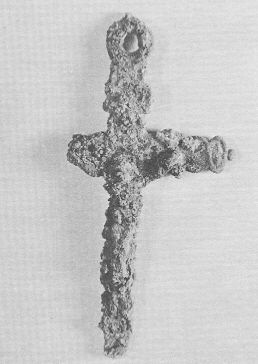
Front of Bronze Baroque Crucifix Found on Left Clavicle of Father Kino's Remains
In Addition To Cassock Button on Sternum
Dr. Romano and I were still cleaning some of the upper bones of Father Kino's skeletal remains when suddenly, as I brushed away the remaining dirt and dust of past centuries, a beautiful bronze crucifix suddenly appeared on the left clavicle. It was exactly 5:55 P.M. The emotion was too much for me. Not only had we found Kino, but we had one more confirmation of his identity: the very crucifix Father Kino had worn on his chest! I was sure this was Father Kino's crucifix. Its baroque style and ornamentation confirmed that it was a 17th century work of art. …. |240|
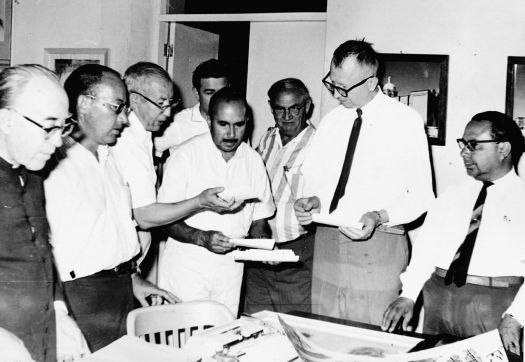
Discovery Team starting in front row from left to right:
Rev. Santos Saenz, Dr. William W. Wasley, Dr. Wigberto Jimenez Moreno,
Dr. Jorge Olvera, Dr. J. Matieila and Rev. Ernest. Burrus, S.J.
Not shown; Rev. Kieran McCarty, O.F.M., Dr. Arturo Romano,
Dr. Gabriel Sanchez de la Vega, Rev. Cruz Acuna Galvez & Conrado Gallegos
Professor Romano had been studying the skull of Burial #2 practically since the day of its discovery at 4:30 P.M. on May 19. Considering the new discovery of the crucifix, he arranged for a meeting of the whole team to discuss whether or not Burial #2 was in fact Father Kino. By now, the majority of us thought that the remains of this interment were those of Kino. The meeting was held in the archives of the Palacio Municipal which, by now, had been turned into the personal laboratory of Professor Romano for his physical anthropological studies, and especially for the study of the skull of Burial #2. This was a closed door seminar. By now, several reporters from the media both of Mexico and the United States had sensed a discovery, and they already suspected that either Burial #1 or Burial #2 could be Father Kino. They had begun to follow us like hounds in search of fresh and exciting news.
None of us wanted any publicity before discussing the question of the identification of the remains thoroughly, and as none of us with the exception of Dr. Romano were physical anthropologists, we felt unqualified from a truly scientific point of view to say whether the re mains of Burial #2 were really those of Father Kino.
Reinterment of Fathers Gonzalez and Iturmendi Beside Kino
The matter of the two-secondary burials that had been found yesterday on either side of those of Burial #2 entered into our discussion. That these were almost certainly the bones of Fathers Gonzales and Iturmendi seemed clear from an entry made by Father Campos in the burial register in 1712. A photostatic copy of the entry had been found by our team of historians in the Magdalena parish archives." It reads as follows: |242|
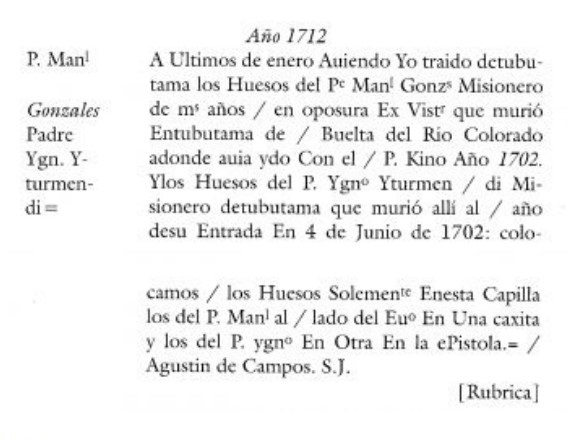
The English version is as follows:
The Year 1712
At the end of January, having brought from Tubutama the bones of Father Manuel Gonzales, missionary of many years in Oposura, ex-Visitor, who died in Tubutama on his way back from the Colorado River where he had gone with Father Kino the year 1702. And the bones of Father Ignacio Iturmendi, a missionary of Tubutama who died there the year of his arrival, on the 4th of June, 1702: We solemnly placed the remains in this chapel, those of Father Manuel on the side of the Gospel in a little box, and those of Father Ignacio in another one on the side of the Epistle.
Agustin de Campos [Rubric]
At this point, we were prepared to believe we had, beyond any shadow of reasonable doubt, located the chapel of San Francisco Xavier and, beneath its floor on the Gospel side of the altar, the mortal remains of Father Eusebio Francisco Kino: We were not, however, yet prepared to make the announcement to the world. That would have to wait for a few more days. |243|
[The End of Jorge Olvera's Discovery Account]
Pronouncement of The Mexican Academy of History
On May 24 the announcement was made to the general public; no doubt remained in the minds of any of the team or the experts called in after the initial conclusion was reached. The Reverend Ernest Burrus of the Jesuit Historical Institute at Rome, who luckily was visiting in Tucson, agreed in full. And finally on July14, 1966, the Academy of History met in Mexico City to review the evidence. Professor Jiménez Moreno presented seventy two depositions explaining the discovery. Then, Dr. Alberto Caso in the name of the Mexican Academy of History pronounced in favor of the identity of the remains. Padre Kino was found at last.
Dr. Charles W. Polzer, S.J.
The Discovery of Padre Kino's Grave
"Kino - A Legacy"
Finding Father Kino's Grave - Two Page Summary Flyer
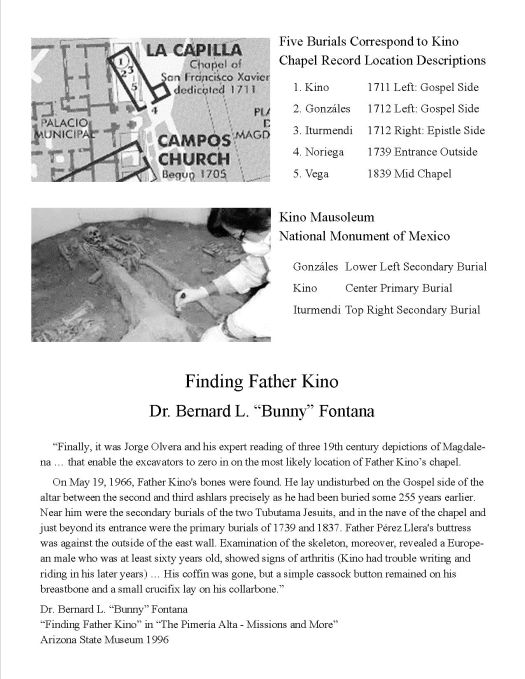
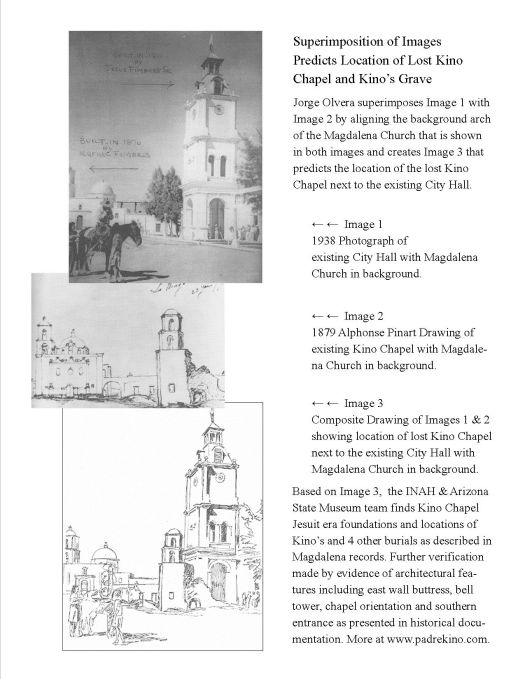
To View and Download "Finding Father Kino's Grave Summary"
Two Page Flyer, click
Summary Page 1
Summary Page 2
To Go To Kino Grave Discovery Site History (page1), click
Grave Discovery Site History Page
To Go To Kino Grave Discovery Chapel (page 2), click
Grave Discovery Chapel Page
